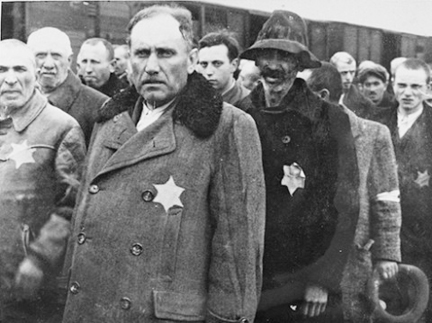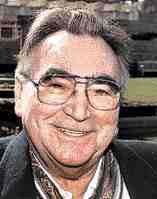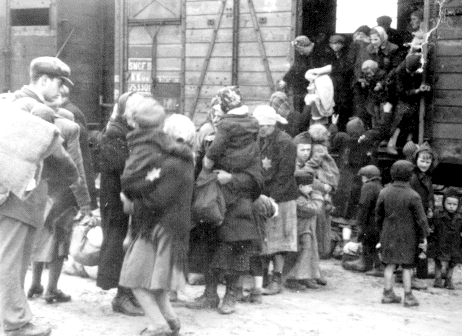The Deportation of the Hungarian
Jews

Hungarian Jewish men
selected for work at Auschwitz-Birkenau

Elderly Jews waiting
to be taken by truck to the gas chamber
On July 9th, the same day that the last
mass transport of Hungarian Jews arrived at Auschwitz, a Swedish
diplomat named Raoul Wallenberg was assigned to the Swedish legation
in Budapest. He was actually working as an agent for the American
War Refugee Board which President Franklin D. Roosevelt had established
in January 1944 at the request of Henry Morgenthau, Jr., the
Secretary of the Treasury. Wallenberg saved thousands of Hungarian
Jews by providing them with an illegal protective passport (Schutz-Pass)
which identified them as Swedish subjects living in Hungary.
Wallenberg set up safe houses for Jewish
refugees in Budapest which were paid for by the Swedish embassy.
Some of the Jewish refugees were housed in the Swedish legation
in Budapest. As a result of Wallenberg's efforts, as many as
200,000 Hungarian Jews were saved, including Tom Lantos, who
emigrated to America after the war and subsequently became a
US Congressman.
When Hungary was liberated by the Soviet
Union, Wallenberg was last seen on January 17, 1945. Ten years
later, the Soviet Union released the information that he had
been arrested as a spy and imprisoned in a Soviet gulag; he allegedly
died in captivity. As a young man, Wallenberg had studied in
the United States and had received a degree in architecture from
the University of Michigan in 1935. He also spoke Russian.
 Rudolf Vrba, aka Walter
Rosenberg
Rudolf Vrba, aka Walter
Rosenberg
The plight of the Hungarian Jews first
came to the attention of the world when, on April 7, 1944, two
Jewish prisoners, Rudolf Vrba, aka Walter Rosenberg, and Alfred
Wetzler, managed to escape from Birkenau, the infamous Auschwitz
II camp where the gas chambers were located. They made their
way back to Slovakia, where Vrba's mother was still living, and
wrote a report which soon reached the hands of the Pope, the
King of Sweden, and even President Franklin D. Roosevelt.
The Hungarian government and Admiral
Horthy were informed that Vrba and Wetzler had proof that the
Jews were being gassed at Auschwitz. Vrba, who worked at the
Judenrampe, the train platform where the Jews disembarked before
the railroad line was extended, had counted the number of Jews
who arrived at Birkenau and were then never seen again. Vrba's
estimate was that 1,765,000 Jews had been gassed at Auschwitz-Birkenau
by March 1944, just before he made his escape.
Two other prisoners, Arnost Rosin and
Czeslaw Mordowicz, also escaped from Auschwitz at the end of
May and wrote a report which told about the beginning of the
"Hungarian Action" and the mass murder of the Jews.
Secretary of the Treasury Henry Morgenthau, Jr. and Judge Samuel I. Rosenman, two Jewish advisors to President Roosevelt, urged him to intervene, according to Robert E. Conot, who wrote "Judgment at Nuremberg." Roosevelt threatened that "Hungary's fate will not be like any other civilized nation's...unless the deportations are stopped." With a population of 125 million people in America in 1933, when the Nazis first came to power, the USA had plenty of room to absorb all of the approximately 15.6 million Jews in the world, but the American Congress would not change the laws that limited Jewish immigrants until 1948.
On July 2, American planes bombed Budapest
and its railroad facilities in an attempt to stop the deportation
of the Hungarian Jews, according to Conot. The King of Sweden
and the Pope also intervened and put pressure on Horthy to stop
the deportation. The bombing of Auschwitz was briefly considered,
but was rejected.
According to a newspaper article by Washington
Times writer Jay Bushinsky in January 2007, Monsignor Angelo
Roncalli, the papal ambassador to Turkey, worked with Chaim Barlas,
a Jewish Agency Rescue Committee official, to persuade the Pope
to help the Hungarian Jews. Roncalli and Barlas worked together
to save around 12,000 Hungarian Jews by making false baptismal
certificates for them and issuing travel papers. Roncalli wrote
letters to Pope Pius XII urging him to ask Miklos Horthy to stop
the deportation of the Hungarian Jews. In June 1944, the Pope
contacted Horthy and asked him to stop the deportation, which
Horthy finally did in July. Roncalli later became Pope John XXIII.
After a meeting on June 26, 1944, the
Hungarian Council of Ministers decided to allow the emigration
of 7,800 Jews, most of whom had papers permitting them to emigrate
to Palestine. On July 17, 1944, the Hungarian government announced
that all Jews who had immigration papers for Palestine would
be given exit visas and allowed to leave.
After Hitler himself put pressure on
Horthy to deport the remaining Jews, the Hungarian government
agreed to begin transporting the Budapest Jews, who had initially
been spared. According to Yehuda Bauer, the plan was to transport
the Jews on 6 trains with 20,000 Jews on each train; the first
train was scheduled to leave on August 27, 1944. When Eichmann
learned of this, he tried to get Horthy to advance the date to
August 20th. Horthy refused and Eichmann requested and received
permission to leave his post in Hungary. The deportation plans
were stopped when the Hungarian government received a telegram
from Reichsführer-SS Heinrich Himmler on August 24th; Himmler
ordered the preparations for the deportation of the Budapest
Jews to cease.
According to the US Holocaust Museum,
there were 200,000 Jews still living in Budapest after the deportations
stopped.
 Hungarian children
arriving at Auschwitz-Birkenau, May 26, 1944
Hungarian children
arriving at Auschwitz-Birkenau, May 26, 1944
On October 8, 1944, Hungary formally
sought peace terms with the Allies, according to the book entitled
"The Last Days," which was published in conjunction
with a documentary by the same name, filmed by Steven Spielberg.
Hitler had anticipated this move, and the SS protected the pro-Nazi
Hungarian leaders of the Arrow Cross fascist political party
from arrest while Otto Skorzeny, the famous German commando,
and his elite unit kidnapped Horthy's son. Horthy's coup was
stopped and the Germans forced Horthy to appoint Ferenc Szalasi
of the fascist Arrow Cross party as the prime minister of Hungary.
Adolf Eichmann then returned to Hungary
and began negotiations with the Hungarian government to deport
50,000 Hungarian Jews to Germany to work in building anti-tank
barriers and in the munitions factories in the concentration
camps. Due to the destruction of the railways by Allied bombing,
the Jews were forced to march on foot to the border between Austria
and Hungary where they were then put on trains and taken to various
concentration camps, including Mauthausen, Gunskirchen and Buchenwald.
Hungarian women were also sent on the march and eventually reached
the main Dachau camp, where they were then sent to one of the
Dachau sub-camps.
One of the 7,000 Budapest Jews, who were
sent to Auschwitz in 1944 and then transferred to Buchenwald
or other camps, was the famous Hungarian novelist and winner
of the Nobel Prize for Literature in 2002, Imre Kertész
. In several novels, Kertész wrote about the Holocaust,
although not about his personal experience.
This page was last updated on December
6, 2009
|